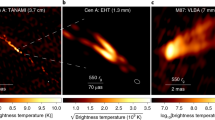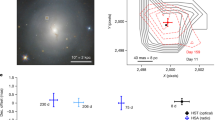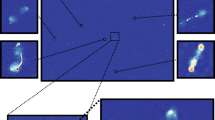Abstract
In recent years the angular distribution of intensity of the compact cores of quasars and radio galaxies has been mapped in detail by very long baseline interferometry (VLBI) arrays1,2. These observations have shown that asymmetric radio structure is common in active nuclei3, and that a high proportion of the brightest sources exhibit superluminal motion4,5. The sources generally have an elongated structure, or jet, which dominates at long centimetre wavelengths, and a compact core at one end of the jet which dominates at short centimetre wavelengths. The association of the core components with the shortest wavelengths, and the most compact features, leads us to link core radiation with the unidentified central engines in these energetic systems. We report here the first detection of interference fringes by VLBI at a wavelength of 3.4 mm (89 GHz). The success of these observations demonstrates the feasibility of millimetre VLBI and opens this important wavelength range to mapping with a resolution of 10−4 arc s. The compact radio source in the nucleus of 3C84 (NGC1275) was observed for a 9-h period on the 485-km (1.4 × 108 λ) baseline between the Owens Valley Radio Observatory and the Hat Creek Observatory. These observations show that the structure is more compact at 89 GHz than at 22 GHz.
This is a preview of subscription content, access via your institution
Access options
Subscribe to this journal
Receive 51 print issues and online access
$199.00 per year
only $3.90 per issue
Buy this article
- Purchase on Springer Link
- Instant access to full article PDF
Prices may be subject to local taxes which are calculated during checkout
Similar content being viewed by others
References
Readhead, A. C. S. Objects of High Redshift, IAU Symp. No. 98, 165–176 (1980).
Kellermann, K. I. & Pauliny-Toth, I. I. A. Rev. Astr. Astrophys. 19, 373–410 (1981).
Readhead, A. C. S. & Pearson, T. J. Extragalactic Radio Sources, IAU Symp. No. 97, 279–288 (1982).
Cohen, M. H. et al. Nature 268, 405–409 (1977).
Cohen, M. H. & Unwin, S. C. Extragalactic Radio Sources, IAU Symp. No. 97, 345–354 (1982).
Blandford, R. D. & Rees, M. J. Pittsburgh Conference on BL Lac Objects, 328–341 (1978).
Rogers, A. E. E. et al. Science 219, 51–54 (1983).
Moran, J. M. et al. Astrophys. J. Lett. 231, L67 (1979).
Moran, J. M. in Methods of Experimental Physics, Vol. 12, Part C (ed. Meeks, M. L.) 174–197 (Academic, New York, 1976).
Readhead, A. C. S., Hough, D. H., Ewing, M. S., Walker, R. C. & Romney, J. D. Astrophys. J. 265, 107–131 (1983).
Author information
Authors and Affiliations
Rights and permissions
About this article
Cite this article
Readhead, A., Masson, C., Moffet, A. et al. Very long baseline interferometry at a wavelength of 3.4 mm. Nature 303, 504–506 (1983). https://doi.org/10.1038/303504a0
Received:
Accepted:
Published:
Issue Date:
DOI: https://doi.org/10.1038/303504a0
This article is cited by
-
Radio observations of active galactic nuclei with mm-VLBI
The Astronomy and Astrophysics Review (2017)
-
The most compact bright radio-loud AGN—I. A new target sample selected for the space VLBI
Astrophysics and Space Science (2014)
-
Relationship between the position angles of elongated structures and polarization vector of the compact radio source 3C84 AT 2, 4, and 6-cm wavelengths
Astrophysics (1997)
-
VLBI imaging with an angular resolution of 100 microarcseconds
Nature (1988)
-
A rapid millimetre wave outburst in the nucleus of NGC1275
Nature (1983)
Comments
By submitting a comment you agree to abide by our Terms and Community Guidelines. If you find something abusive or that does not comply with our terms or guidelines please flag it as inappropriate.



